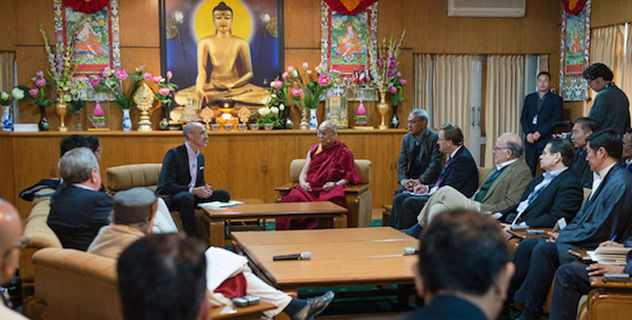His Holiness the Dalai Lama hosted a two day symposium at his residence in Dharamshala, in cooperation with Washington based think-tank American Enterprise Institute (AEI), beginning on Wednesday November 4. It was the second symposium the AEI has held with His Holiness. The discussion was moderated by Arthur Brooks, President of AEI and wasattended by noted panellists such as the Tibetan Prime Minister in Exile Lobsang Sangay, Finance Minister Tsering Dhondup, Home Minister Dolma Gyari and members of the Tibetan Chamber of Commerce.
The symposium’s first panel entitled Abundance without Attachment aimed to discuss the pursuit of happiness in a world of economic growth and His Holiness stressed the need to bridge the gap between rich and poor. The panel additionally focused on the question of what is a meaningful life in the midst of poverty and highlighted the importance of development in rural areas of India. It was stated that the rich should provide facilities and education respectfully whilst the poor should work hard and develop self-confidence in their individual contribution to communal productivity. His Holiness ended the first day’s panel with the remark that we are social animals and therefore need to take the welfare of all humanity into account. He pointed out that whether we are rich or poor, the size of our stomach is the same and we all have ten fingers.
The second panel was moderated by Danielle Pletka, Senior Vice President of foreign and defence policy studies at AEI.The panel addressed the topic of building business in India’s slums. The AEI has taken special interest in a slum in Mumbai called Dharavi, home to between 700,000 and one million people. Representatives from the slums took part in the panel and explained that the people in Dharavi look after each other and try to get a good education in order to live a better life. In Dharavi there is social harmony and development not achieved by charity or through government help, but by peoples’own efforts. It was noted that development in India starts from below and is therefore more sustainable.





 Print
Print Email
Email